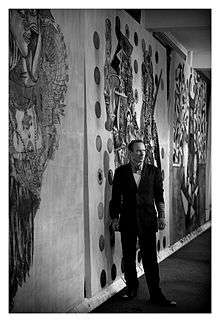Wolfe von Lenkiewicz
| Wolfe von Lenkiewicz | |
|---|---|
 Lenkiewicz in his Melton Street studio | |
| Born |
1966 Dartmoor, England |
| Nationality | British |
| Notable work | London, United Kingdom |
Wolfe von Lenkiewicz (born 1966) is a British artist known for his artistic reconfigurations of well-known imageries from art history and visual culture to create ambiguous compositions that question art historical discourses.[1] He lives and works in London.[2]
Early life and education
Wolfe von Lenkiewicz was born in Dartmoor, England, England, in 1966 to Celia Norman and the British painter Robert Lenkiewicz.[3] He is of German-Polish-Jewish descent, with his great-grandfather being Baron von Schlossberg, court painter to King Ludwig II of Bavaria.[4] Lenkiewicz was educated at University of York, graduating in 1989 with a degree in Philosophy.[2]
Artistic career
Lenkiewicz exhibited 33 drawings including 3 large-scale works at his first major exhibition, Nu-Trinity, at Dickinson in 2007.[3][5] Richard Dyer described the exhibition as 'an iconographic investigation into the power inherent in certain images and events, and the mythos associated with them'.[5] Lenkiewicz’s works have since then been exhibited internationally, including Tate Britain and All Visual Arts in London, Triumph Gallery in Moscow, Palais des Beaux-Arts in Lille, as well as in Dublin, Hamburg, Berlin and Venice.[2]
His works primarily deal with the appropriation of language and mythology[6] by juxtaposing elements such as religious figures, pop culture icons, literary characters and motifs.[7] Lenkiewicz's drawings and paintings often reference iconic imageries, including those by Albrecht Dürer, Pablo Picasso, Andy Warhol, and Hieronymus Bosch. Lenkiewicz transforms Dürer's Self-Portrait (1500) in his Werewolf (2011), referencing Jacques Derrida's The Beast and the Sovereign.
Selected exhibitions
In 2009, Lenkiewicz's solo exhibition titled The Descent of Man exhibited over 80 works in a former landmark bank building by Arthur Beresford Pite in London.[8] In the following year, Lenkiewicz's Victory Over the Sum opened in Triumph Gallery in Moscow, showcasing works including But, but I am a Legend (2010), a painting in which motifs such as Marie-Therese Walter's head from Picasso's portrait and François Boucher's Odalisque have been assimilated into the iconic Guernica (1937).[9]
Lenkiewicz has participated in many group exhibitions including Zwei Sammler: Thomas Olbricht und Harald Falckenberg in Deichtorhallen, Hamburg in 2011; as well as Babel, in Palais des Beaux-Arts, Lille in 2012. At Deichtorhallen, Lenkiewicz exhibited Ace of Spades (2009),[10] which is in the collection of German collector Thomas Olbricht.
Lenkiewicz's latest body of works are inspired by Hieronymus Bosch, transforming The Garden of Earthly Delights (ca.1490) into a 'post-historic, trans-cultural manuscript'.[11]
References
- ↑ 'Wolfe von Lenkiewicz', AnOther Magazine, 26 April 2011
- 1 2 3 'Wolfe von Lenkiewicz', Other Criteria
- 1 2 'Market news: Warhol's Conrad Black legacy', Colin Gleadell, The Telegraph, 23 October 2007
- ↑ Art Review blog, 17 February 2010
- 1 2 "Wolfe Lenkiewicz: Nu-Trinity”, Richard Dyer, Art Review, January 2008
- ↑ 'Wolfe von Lenkiewicz', James Read, Don't Panic Online, 18 May 2011
- ↑ 'Wolfe von Lenkiewicz / Age of the Marvellous', Dazed Digital, September 2010
- ↑ Art Daily
- ↑ 'Wolfe von Lenkiewicz at the Triumph Gallery', John-Paul Pryor, February 2011
- ↑ 'The Deichtorhallen Shows Works from the Collections of Thomas Olbricht & Harald Falckenberg', Art Knowledge News
- ↑ Art Review blog, 11 July 2012